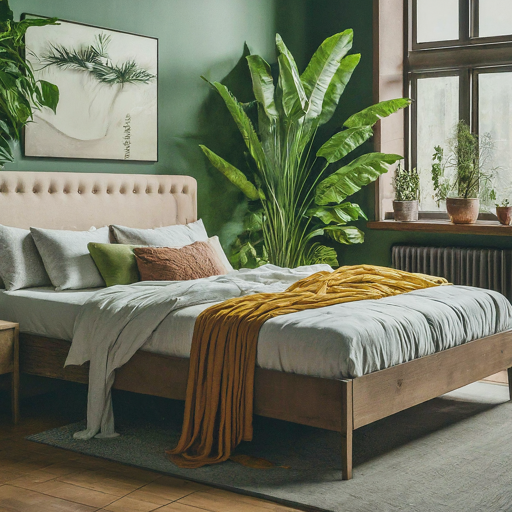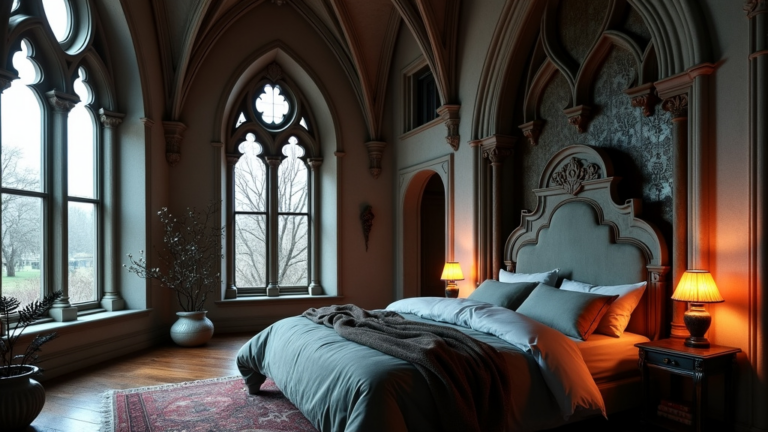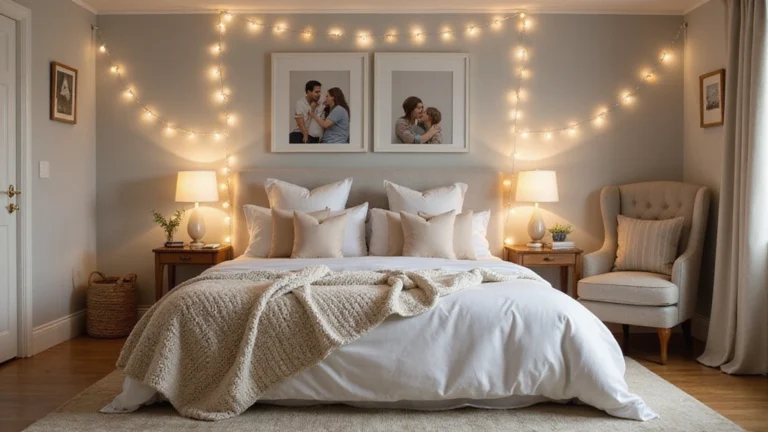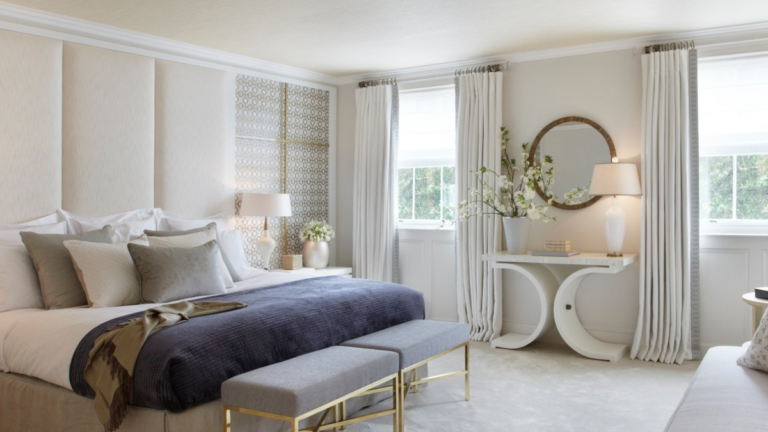22 Complementary Color Bedroom Ideas That’ll Instantly Transform Your Space
Let’s be honest—picking the right bedroom colors is harder than it looks. You stare at paint swatches for hours, and they all somehow look the same shade of beige.
Sound familiar? Don’t worry, I’ve been there too.
The secret isn’t just picking colors you like—it’s finding complementary color combinations that work together to create a mood, a vibe, a little “wow” moment every time you walk in.
Complementary colors—those opposite on the color wheel—create the kind of contrast that looks effortlessly stylish.
They balance each other, giving your room energy and harmony at the same time. So, if your bedroom feels a bit “meh,” it might just need a color couple’s therapy session.
Here are 22 complementary color bedroom ideas that’ll take your space from basic to beautifully balanced.
1. Blue and Orange: The Bold Balance
Blue brings calm, orange adds warmth—together, they’re unstoppable. Think navy walls with burnt orange throw pillows or a sky-blue duvet against a terracotta rug. The contrast is bold but still cozy.
Ever noticed how beach sunsets look incredible? That’s basically nature’s version of this combo.
2. Green and Pink: Nature Meets Playfulness
This duo is proof that opposites really do attract. Soft sage green walls paired with dusty rose bedding create a peaceful, romantic atmosphere without being too sweet.
If you’re braver, go with emerald green and blush pink—trust me, it looks like a boutique hotel room.
3. Yellow and Purple: Vibrant and Regal
Purple screams luxury, yellow adds cheer. When they meet? Magic.
Try lavender walls with mustard accents—like cushions, lamps, or art. It’s bright but grounded, regal but not “I live in a castle” regal.
4. Red and Teal: Dramatic Yet Sophisticated
If your bedroom needs attitude, this one’s your match. Deep red bedding paired with teal curtains or a velvet chair gives an elevated, sultry feel.
FYI, teal keeps red from feeling too overpowering, while red keeps teal from looking too cold. Balance, my friend.
5. Black and Gold: The Luxe Statement
You can’t go wrong with this timeless pair. Matte black walls or furniture against gold accents instantly create a high-end look.
Want a trick? Add mirrors or metallic light fixtures to keep it from feeling too dark.
6. Navy and Copper: Industrial Meets Warmth
Navy and copper are like the cool couple who somehow make everything look effortless. Navy walls with copper lamps or frames add instant sophistication.
Throw in a tan leather chair for texture and warmth.
7. Mint Green and Coral: Refreshing and Uplifting
This combo is perfect if you love a bright, happy space. Mint walls and coral cushions or artwork keep things light and breezy.
Pro tip: use white bedding to let the colors pop without overwhelming the room.
8. Charcoal and Blush: Soft Meets Strong
Charcoal gray adds depth; blush pink adds warmth. Together, they create modern romance.
Ever tried charcoal walls with blush curtains? It’s moody and delicate all at once.
9. Turquoise and Tangerine: Tropical Energy
Feeling bold? This one’s pure vacation vibes. Think turquoise bedding with tangerine pillows or a tangerine accent wall behind turquoise decor.
It’s fun, energetic, and perfect if you don’t take design too seriously. 🙂
10. White and Navy: Classic and Crisp
White and navy are the OGs of complementary color style. They scream clean, timeless elegance.
Try navy headboards, white bedding, and maybe a striped rug for that nautical hint. Simple, sharp, and stylish.
11. Beige and Blue: Earthy and Calm
If you love neutrals but still want some contrast, beige and blue make an excellent pair.
Beige walls with soft blue accents give a serene, spa-like vibe. Perfect for those who believe their bedroom should feel like a sanctuary.
12. Plum and Olive: Rich and Unexpected
Want something unique? Plum and olive green feel rich, moody, and designer-level.
Go for plum bedding and olive curtains or vice versa. Add brass details for a warm touch.
13. Rust and Navy: Rustic Meets Cool
This combination is effortlessly trendy. Rust orange tones bring coziness, while navy keeps things sleek.
It’s ideal for autumn lovers who want that “cabin chic” aesthetic all year round.
14. Black and White: Timeless Contrast
Sometimes simple wins. You can’t mess up black and white, but you can make it boring if you’re not careful.
Layer textures—like faux fur throws, linen bedding, or patterned rugs—to keep it dynamic.
15. Coral and Teal: Vibrant Yet Balanced
This combo is full of personality. It’s bright but surprisingly harmonious.
Try coral curtains with teal bedding, or vice versa. Want to tone it down? Add neutrals like beige or white to soften the punch.
16. Lavender and Sage: Soft and Soothing
If you crave a peaceful retreat, look no further. Lavender walls and sage accents create a dreamy, botanical feel.
This combo is basically the visual equivalent of a spa day.
17. Terracotta and Blue: Warmth Meets Cool
This one’s made for boho lovers. Terracotta tones bring earthiness, while blue adds balance and freshness.
Add natural materials like rattan or wood for that grounded, organic vibe.
18. Olive and Blush: Cozy and Romantic
Olive green feels cozy and grounded, while blush pink adds a soft, romantic edge.
Go for olive walls with blush linens and a neutral rug to tie it all together.
19. Mustard and Navy: Retro Cool
This one’s got mid-century modern written all over it. Mustard bedding and navy decor create a stylish, retro-cool space.
Add walnut furniture, and you’re basically living in a Pinterest board.
20. Peach and Forest Green: Fresh and Warm
If you’re tired of neutrals but don’t want anything too loud, this is a great middle ground.
Peach walls soften the space, while forest green accents add structure and sophistication.
21. Taupe and Deep Blue: Understated Elegance
This pairing whispers luxury without shouting about it. Taupe walls with deep blue bedding look effortlessly refined.
It’s ideal if you prefer a minimalist aesthetic with a touch of class.
22. Gray and Yellow: Cheerful and Modern
Gray can feel dull alone, but pair it with yellow, and suddenly it’s alive.
Gray walls with mustard accents or yellow lamps create a modern, uplifting energy that still feels cozy.
Bonus Tips for Using Complementary Colors
Because, IMO, color theory deserves a quick cheat sheet:
- Pick one dominant color and use its complement as an accent. That keeps the look balanced, not chaotic.
- Layer neutrals like white, beige, or gray to prevent the colors from clashing.
- Use textures (linen, velvet, wood) to make the space feel dynamic, not flat.
- Lighting matters. Warm light can make cool colors feel cozy, and vice versa.
- And my personal favorite rule: test before you commit. Paint a sample section and stare at it for a few days. Trust me—your future self will thank you.
Common Mistakes People Make (and How to Avoid Them)
Let’s be real for a second. We’ve all made a few oops moments in our decorating journeys. Here’s how to dodge the big ones:
- Too much contrast. Bold color pairs look great, but if everything’s shouting for attention, your eyes won’t know where to land. Use bold hues strategically.
- Ignoring undertones. Not all blues or reds play nicely together. Warm undertones clash with cool ones—always check that your chosen colors share the same temperature family.
- Skipping texture. A complementary color scheme without texture feels flat. Mix materials—think cotton, velvet, and metal accents.
- Over-decorating. Just because the colors complement doesn’t mean you need both on every surface. Sometimes, less is more (I know, shocking).
Why Complementary Colors Work So Well
Here’s the nerdy but necessary part. Complementary colors sit opposite each other on the color wheel, which means they balance each other perfectly.
When you put them together, your brain perceives the combo as dynamic and satisfying. It’s like visual harmony—a little push and pull that feels right.
Ever wondered why blue and orange movie posters are everywhere? Same reason. The contrast makes everything pop. So, if filmmakers swear by it, maybe it’s worth trying on your walls too.
Final Thoughts
So there you have it—22 complementary color bedroom ideas that can totally change the feel of your space. Whether you go for bold and vibrant (hello, red and teal) or soft and soothing (looking at you, lavender and sage), the goal is balance.
Decorating should be fun, not stressful. Your bedroom is your personal retreat, so pick combinations that make you feel good. Play around, mix swatches, make mistakes—it’s all part of finding your style.
And hey, if you accidentally paint one wall the wrong shade? No big deal. That’s just another reason to call it “artsy.”





